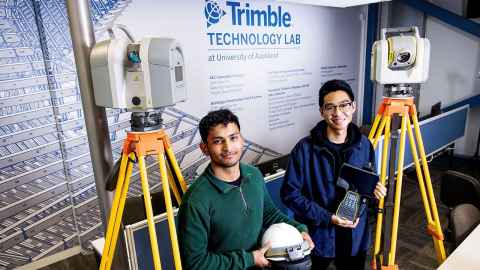Trimble Technology Lab puts cutting-edge tech in students’ hands
12 September 2023
Students across the University are making the most of having access to the latest cutting-edge software and equipment used in the fields of engineering, architecture and the construction industry, as well as in transportation and agriculture.

The technology comes as part of a gift agreement between the University of Auckland and US company Trimble, and is centred in the new Trimble Technology Lab, located in the Faculty of Engineering.
One student using the technology is Lux Dhakal, who is in his final year of a Bachelor of Engineering degree, specialising in civil engineering.
Lux is working on a project, led by senior lecturer Sandeeka Mannakkara, to make the Ōpeke Marae in Ōpōtiki more climate resilient. As part of his studies, he has been using a hi-tech Trimble TX8 3D scanner, which he describes as being a game-changer for the type of work he does.
The technology has allowed Lux and the team working on the project, which includes his fellow student Duncan McDonald, to take a highly detailed scan of the marae buildings. From that scan, they have then been able to construct very detailed 3D virtual models of the buildings that can be used in modelling and testing design ideas at any time, without the need for engineers to physically visit the site.
“So every time we need to try to add something to the structure, we can go into the cloud model that we made with the scanner and look at the fine details, take fine measurements and try to see if what we're suggesting will actually work.”
Having worked with similar scanners before, Lux says he was blown away by how intuitive and user-friendly the technology is.
“I was amazed by how easy it is to use. You don't have to be skilled in 3D modelling to use it, which makes it really easy for students like me.”
The aim of the project, which is being carried out in collaboration with rangatira from the hapū Ngāti Ira, is to improve the resilience of the marae during disasters and climate emergencies, allowing it to be used as an evacuation refuge for all locals during disaster events. Although the marae has long been used as a safe haven by those living in the area, its ageing structure, lack of stormwater management, vulnerable communication infrastructure and limited bathroom facilities mean it struggles to provide for those in need during emergency situations. Lux says this project aims to identify specific upgrades and processes from international best practice to equip the marae to have the capacity to house up to 1,000 people for three days in the event of a disaster (the goal of the hapū).
Another student benefiting from Trimble technology at the University is Karmkate Insawad, who is in his first year of a Master of Architecture degree.
Karmkate primarily uses SketchUp, which he says is indispensable for his architectural studies. He says the programme fits seamlessly into his creative design process.
“Starting off a design brief, I usually sketch out key ideas and then I take those sketches into SketchUp. I start modelling masses, which gives you the heights, set boundaries, etc,” he explains.
Karmkate also uses the programme to import GeoMaps data from Auckland Council, which he can then use to create site models for any plans he is working on.
He says one of the best parts of the programme is how despite being a hugely powerful tool used by professionals in the industry, it’s not overly complicated.
“SketchUp drew me in because it was so simple and straightforward to use. I just love how easy it is, how quickly you can make a box that gives you massing, and then you can see where your design can go.”
Being familiar with the software, which is used throughout the architecture industry, also gave Karmkate an advantage during a recent internship he completed. And as a teaching assistant at the School of Architecture and Planning’s Digital Research Hub, Karmkate also teaches other students how to use the software, passing on his knowledge.
As well as helping students like Karmkate and Lux, the technology is also being used in a number of other novel and astonishing ways, allowing students to tap into the enormous potential offered by the sophisticated software and hardware available through the Trimble Technology Lab.
“They have so much cool stuff,” says Lux. “And it's all useful in real life as well, it's not just for research – all that technology is used in real engineering.”
Media contact
Helen Borne | Communications Manager
Alumni Relations and Development
Email: h.borne@auckland.ac.nz